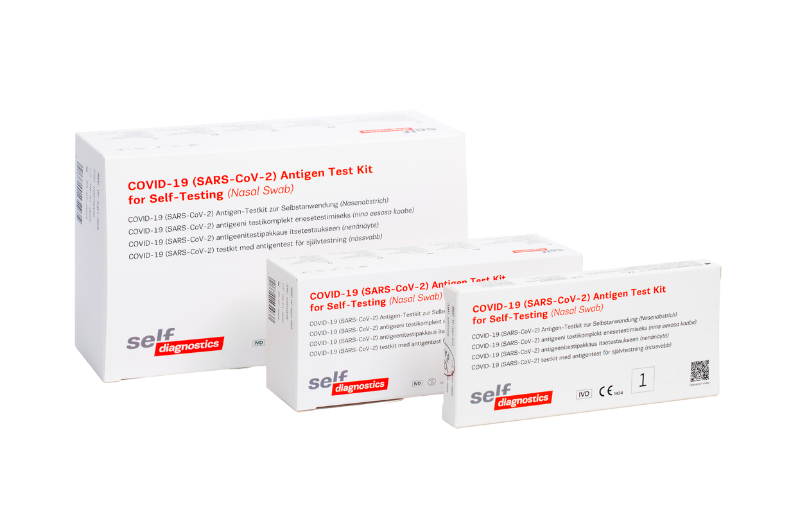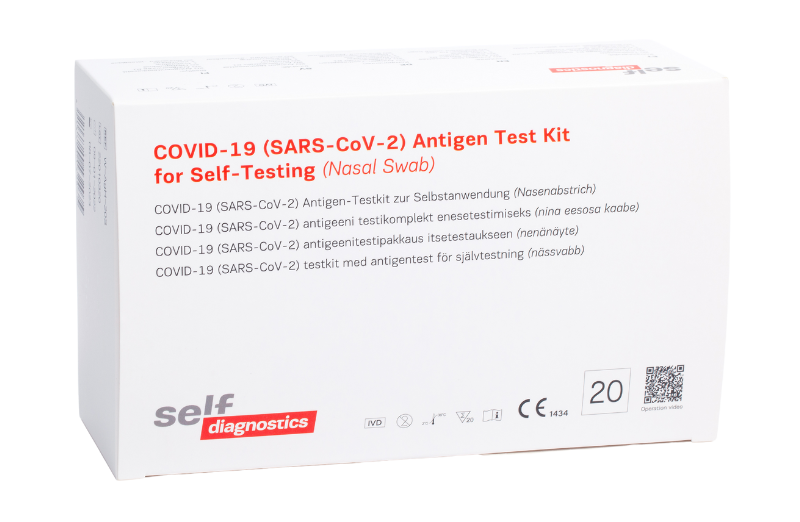COVID-19
Antigen Rapid Test
Sensitive and accurate
self-test
Accuracy
Specificity
Sensitivity
Use only reliable tests!
The Paul Ehrlich Institute (in Germany) compared the sensitivity of antigen tests using samples with varying amounts of the virus. The study shows that our test has excellent sensitivity indicators.Keep your loved ones safe!
The test detects infection even if you have no symptoms! This way, you can take steps to reduce the risk of infecting your family, friends or colleagues. Test yourself before attending the birthday of a grandparent or going to the theatre with your partner.The coronavirus is quicker than you are!
The coronavirus can replicate thousandfold inside the body in a very short time. If your morning test comes back negative, but you’re still feeling unwell, retest!- German Federal Institute for Drugs and Medical Devices (BfArM)
- German Medical Devices Information and Database System (DMIDS)
- The Paul-Ehrlich-Institut – Federal Institute for Vaccines and Biomedicines
- The UK Health Security Agency (UKSHA)
- Austrian Federal Office for Safety in Health Care (BASG)
This antigen test is convenient to take!
- All you need is 2-3 minutes and the results come back in 15 minutes!
- Pre-filled tubes help prevent any mistakes.
- All you need for the sample is to swab the front of your nose at a depth of just 1.5 cm. This means no sneezing or itching.
- Testing is easy and anyone can do it.
- Highly rated by the German independent laboratory Biomax on the test’s reliability and usability.

Different rapid antigen tests have different levels of sensitivity.
- If the test’s sensitivity is high, the better the test recognises the virus even when there isn’t much of it in the body.
- Good sensitivity of the test is important also when taking a sample from the nose and there isn’t enough virus on the swab.
- In the case of antigen tests with low sensitivity, the risk of false negative results is remarkably high!
FAQ
The rapid antigen test is sensitive to a high viral load, which is the period when the risk of infection is most likely and highest.
1) When taking the test, follow the package insert carefully.
2) Make sure that the sample is taken properly by following the instructions for use exactly. If the sample isn’t taken properly, the test will not show the correct result!
3) To take a sample, choose a room where no eating takes place, which is ventilated and where surfaces can be cleaned and disinfected. Make sure that there are no more persons in the room than necessary, as sampling is an infectious process.
4) Before taking the test, clean your hands and the surfaces you are using. Remember to clean your hands and the surfaces once you’ve taken the test.
The result of the rapid antigen test is negative
A negative test result means one of the following: a) the test didn’t detect a SARS-CoV-2 virus antigen in the sample. b) or the amount of virus in the sample was so low that the test was unable to detect infection. When in doubt, retest in 1-2 days.The result of the rapid antigen test is positive
In the case of a positive result, a large amount of SARS-CoV-2 virus was detected in the sample, indicating a risk of infection.Rapid antigen test negative/ PCR-test (laboratory test) positive
- a) The instructions for use in the package insert must be followed when sampling and testing. The test will only work with the indicated accuracy if it has been performed exactly as instructed.
- b) If a person has previously been infected with the SARS-CoV-2 virus, the virus may remain in the body for a longer period of time, which can be detected by a PCR test due to high sensitivity and show a positive result.
- c) When the disease is in its early stages, the amount of virus in the body is generally low and therefore below the detection limit of the rapid antigen test, giving a negative test result. At the same time, the PCR test result may be positive due to the higher sensitivity.
- d) The virus multiplies very quickly. In one day, the amount of virus in the body can increase up to 1000 times. The rate of viral increase differs for each individual and the test results in this case are influenced by the time the test is performed. Therefore, it is logical and possible that the results of the tests performed at daily intervals will differ – one day negative, the next positive.
| CONCEPT | EXPLANATION |
|---|---|
| EU Common list | All devices included in the EU common list of COVID-19 antigen tests (COVID-19 antigen tests for professional use and COVID-19 laboratory-based antigenic assays) are meeting the criteria agreed by the Health Security Committee. All devices included in the EU common list of COVID-19 antigen tests and carried out by health professionals or by skilled testing personnel can be used by EU Member States to issue EU Digital COVID test and recovery certificates. |
| MSA registration, Health Board registration | A database of medical devices and aids managed by the Board of Health. Its purpose is, among other things, to register, collect, process, analyze and transfer to the European Medical Devices Data Bank the data of medical devices launched on the market, introduced, first distributed and first professionally used in Estonia, as well as data on medical device incidents, clinical trials and monitoring procedures; Registration in MSA does not give an assessment of the quality of the device, and it does not mean the approval of the Health Board, and registration of the device in MSA is not allowed to be used for advertising the device. |
| Antigen rapid test | The test results are revealed after 15-30 minutes after taking the test. Rapid tests are commercially available for professional use as well as for self-testing (so-called home testing). The test detects a high viral load in the body. If the amount of virus in the body is high, the person is infectious at the time of the test. Rapid antigen tests can be separated by the following: *based on the type of users: antigen tests used by qualified personnel (sampling, evaluation and interpretation by qualified medical personnel). Antigen test for self-testing (sampling, evaluation and interpretation by the person tested). *based on the manner or place of sampling (front of the nose, throat, nasopharynx, saliva). |
| Tests for professional use. | These tests are intended for use by healthcare professionals at places where healthcare is provided (near the patient) or in medical facilities. |
| Self-test, home test, rapid antigen test for self-testing | These tests are intended for self-administration by laypersons, i.e. for you. The test can be taken by anyone who isn’t a medical officer. |
| The Limit of Detection (LoD) | Infection can only be detected by a test that is sufficiently sensitive, in other words, the limit of detection (LoD) is low enough. Honest manufacturers allow the LoD of their test to be verified by a reference institution. Example. You have two coffee cups, one with 10 grains and the other with 100 grains of sugar. You have two rapid tests, both claiming to be able to detect the presence of sugar in the cup with 97% probability. Clearly, the test that can detect sugar in a cup with just 10 grains is superior as its LoD is much lower. Even though there’s another manufacturer that claims it can detect the presence of sugar in a cup with 97% probability, that manufacturer leaves out that it can only do so if there are at least 100 grains of sugar in the cup. |
| Sample type: Nasal Swab | Tests from the front of the nose are taken from inside the nostril at a depth of 1-2.5 cm. That is about as much as your finger would be able to fit inside your nose. Children even refer to this test as the nose picking test. |
| Sample type: Nasopharyngeal Swab | This sample is taken from a nasopharyngeal swab, at a depth of about 7-10 cm. Think of an imaginary line from the tip of your earlobe to the tip of your nose – the swab is pushed about halfway between that distance. We’d like to emphasise that there’s no direct access to the brain through the nose, so you can’t hurt the brain with a nasopharyngeal swab. |
| Sample type: Saliva | The reliability of a saliva test is highly-dependent on the person taking the test and the procedure used to collect the sample. The result depends on the following: * what and when the person has eaten and had to drink (no eating, drinking, smoking, etc. before the test); * which part of the mouth the saliva comes from and how long it’s been there – (the virus tends to wash away with saliva in the front of the mouth); * the saliva of different people can have varying viscosity, it may be frothy, there might not be enough of it for the test, etc. Spitting into a specimen container also risks contaminating the sample container or surrounding surfaces with infectious material. Due to the low reliability of the test, there are no saliva tests approved for home use on the list of accepted tests in the EU. |
| Sample type: Oropharyngeal Swab | The sample is taken from deep in the throat (around the palatine tonsils). There are other tests in which case a sample is taken from fluid used for gargling, but these also have a number of limitations (see saliva tests). |
| PCR test | The RNA (ribonucleic acid) of the genetic material of the virus is determined using the PCR or polymerase chain reaction method that requires specific machinery, specially trained laboratory technicians and an adapted laboratory process. A PCR test detects: * whether you are infectious AT PRESENT or * since the PCR test is many times more sensitive, the test can detect whether you have been infected or have contracted and recovered from the disease in the past (without signs of disease). The test detects so-called virus traces. In this case, the person is no longer infectious. |
| Prefilled extraction tubes | For tests where the test solution is not ready inside tubes and must be prepared manually by the tester. Since the mouth of the tube is relatively narrow and the quantity of liquid inside the large refill bottle is quite precise (considering the number of tests in the box), filling the tubes can take some time and is certainly more complicated and cumbersome than using prefilled tubes. Such tests are generally intended for professional use. |
| Sensitivity and Specificity. Accuracy. | The reliability of a test depends on its sensitivity and specificity. Sensitivity determines how well the test detects the presence of an infection (the percentage of positive results among infected subjects during trials). Specificity determines how well the test detects the absence of an infection (the percentage of negative results among non-infected subjects during trials). Accuracy is the aggregate of test specificity and sensitivity. |


